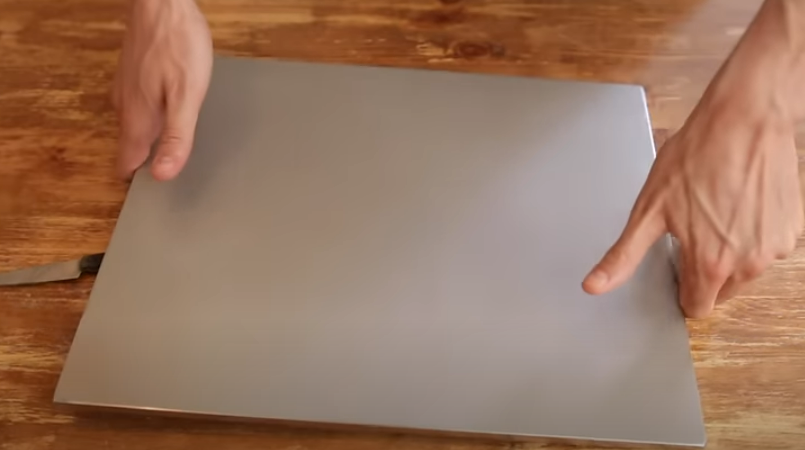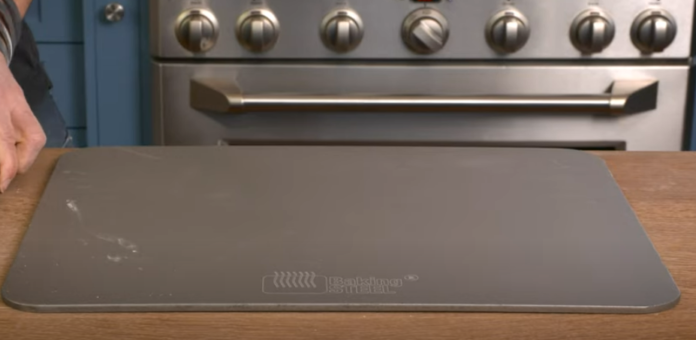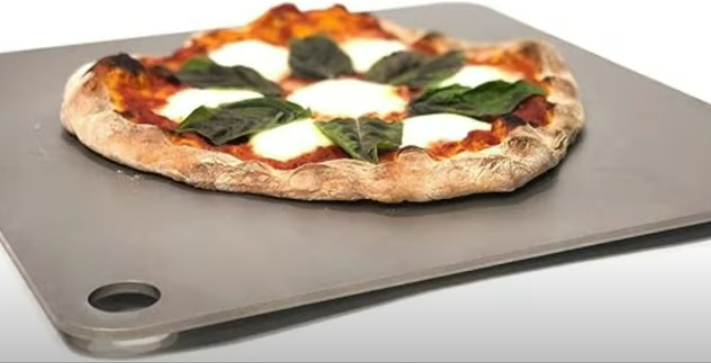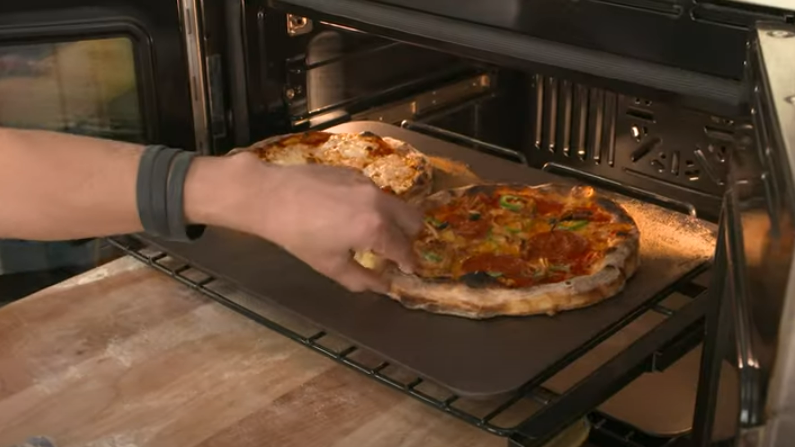Pizza steel should generally be at least ¼ inch thick for optimal pizza baking results. The thickness helps distribute and retain heat evenly, resulting in a crispy crust.
A pizza’s thickness is crucial to achieving the perfect pizza crust. Thicker steels provide better heat retention and distribution, resulting in a crispy, evenly cooked pie. Thin steels may not provide the same level of heat retention, leading to a less satisfying end product.
When selecting pizza steel, aim for a thickness of at least ¼ inch to ensure consistent and delicious results every time you bake a pizza. Thickness matters when baking the perfect pizza on a steel surface. So, choose wisely to elevate your pizza-making game.
Why Pizza Steel Is Essential
When creating the perfect pizza at home, having the right tools can make all the difference. One essential tool that every pizza lover should have is a pizza steel. A pizza steel is a thick, flat sheet of steel or iron used to bake pizzas. It is placed in the oven and heats up quickly, providing a consistent and even heat distribution. The result? A crisp and perfectly cooked pizza with a golden brown crust and a deliciously chewy interior.
The Source: How Long to Preheat Pizza Steel
Benefits Of Using Pizza Steel
There are several benefits to using pizza steel over traditional baking surfaces like pizza stones or pans:
- Superior heat retention: Pizza steels are known for their exceptional heat retention properties. Their high thermal conductivity allows them to not only absorb heat quickly but also retain it for an extended period. This means that your pizza will bake evenly from top to bottom, giving you a consistent result every time.
- Faster cooking time: With the superior heat conductivity of pizza steel, your pizzas will cook faster compared to other baking surfaces. This is because the steel transfers heat more efficiently, resulting in shorter cooking times. So, if you’re craving a piping hot pizza in a hurry, a pizza steel is the way to go.
- Crust perfection: One of the hallmarks of a great pizza is a perfect crust. A pizza steel helps you achieve that elusive crispy and chewy crust that is synonymous with restaurant-style pizzas. The steel’s intense heat ensures a uniform rise and allows the crust to develop a lovely caramelization.
- Versatility: Pizza steels are incredibly versatile and can be used for more than just baking pizzas. You can use them to cook flatbreads, calzones, cookies, and more. They are also great for reheating leftovers, delivering that fresh-out-of-the-oven flavor even the next day.
Difference Between Pizza Stone And Pizza Steel
While both pizza stones and pizza steels are popular choices for baking pizzas, some significant differences set them apart:
| Pizza Stone | Pizza Steel |
|---|---|
| Slower heat transfer | Higher heat conductivity |
| Longer preheating time | Quicker preheating |
| Brittle and prone to cracking | Durable and virtually indestructible |
| Less consistent heat distribution | Even heat distribution |
| Can absorb moisture from the dough | Does not absorb moisture |
In conclusion, pizza steel is an essential tool for any pizza enthusiast. Its superior heat retention, faster cooking time, and ability to create the perfect crust make it a must-have for achieving restaurant-quality results at home. So, why settle for mediocre pizzas when you can elevate your homemade creations with the help of Pizza Steel?
The Source: How to Use Baking Steel for Pizza
Understanding Pizza Steel Thickness
When it comes to making perfect pizzas at home, the thickness of your pizza steel plays a crucial role in achieving that desired crispy crust and even cooking. Understanding pizza steel thickness is key to creating professional-quality pizzas in your kitchen.
How Thickness Affects Pizza Crust
Pizza crust thickness depends on the steel thickness. Thin steel offers a crispier crust, while thicker steel results in a chewier texture.
Common Thickness Options For Pizza Steel
Various thickness options are available for pizza steels, including:
- 1/4 inch (6.35mm): Provides quick heat transfer for crispy, thin crusts.
- 3/8 inch (9.5mm): Offers a balance between crispy and chewy crusts.
- 1/2 inch (12.7mm): Ideal for deep-dish or chewy Neapolitan-style crusts.
Factors To Consider For Pizza Steel Thickness
Types Of Pizza Crust
When considering the ideal thickness for pizza steel, the type of pizza crust you prefer is a crucial factor. A thicker steel plate with a thickness of ½ inch or more is recommended for thick, deep-dish, or stuffed crust pizzas. On the other hand, if you prefer a thin and crispy crust, a thinner steel plate, around ¼ inch thick, will suffice.
Oven Heating Capacity
The heating capacity of your oven also plays a significant role in determining the thickness of the pizza steel. For ovens with lower heat retention, a thicker steel plate is essential to provide the necessary thermal mass for efficient heat transfer. Conversely, high-powered ovens may perform well with a thinner steel plate, around ¼ inch, to prevent the crust from burning before the toppings are fully cooked.
Preferred Pizza Style
If you have a preferred pizza style, it will impact the ideal thickness of the pizza steel. Those who enjoy Neapolitan-style pizzas, with their characteristic thin, slightly charred crust, would benefit from a thinner steel plate, typically around ¼ inch thick. If you lean towards New York-style or Sicilian-style pizzas, a thicker steel plate, between ½ to ¾ inch, may be more suitable to achieve the desired crust texture and bake.
Optimal Thickness For Thin Crust Pizza
When it comes to creating the perfect thin-crust pizza, the optimal thickness of the pizza steel plays a crucial role. Achieving that crispy, yet chewy and flavorful thin crust requires the right balance of heat transfer and insulation provided by the pizza steel. Let’s dive into the recommended thickness range for achieving the perfect thin-crust pizza.
Achieving Crispy Thin Crust
To achieve a crispy, thin crust, the pizza steel needs to effectively transfer heat to the dough while maintaining the ideal balance of moisture. An optimal thickness ensures that the steel heats up quickly to create a crispy bottom while also retaining enough heat to cook the toppings and melt the cheese without overcooking the crust.
Recommended Thickness Range For Thin Crust Pizza
For thin-crust pizzas, the recommended thickness range for the pizza steel typically falls between 3/16 inch to 1/4 inch. This thickness allows for efficient heat transfer, creating a crispy crust while preventing the dough from becoming too dry or charred.
When selecting pizza steel for thin-crust pizzas, a thickness in this range ensures that the crust cooks evenly and quickly, resulting in a perfect thin-crust pizza with just the right amount of crispiness and chewiness.
Optimal Thickness For Neapolitan Pizza
Discovering the ideal thickness for Neapolitan pizza steel is crucial in achieving that perfect crispy yet chewy crust. Opt for a steel thickness of around 3/8 inches to ensure even heat distribution and phenomenal baking results. Balancing thickness with heat retention is key for a stellar pizza-making experience every time.
Preserving Soft And Chewy Texture
To achieve the authentic Neapolitan pizza texture, opt for a steel plate between ¼ and ½ inch thick.
Recommended Thickness Range For Neapolitan Pizza
A thickness of ¼ inch to ½ inch ensures the ideal balance of heat retention and heat transfer for the perfect Neapolitan pizza.
Optimal Thickness For New York-Style Pizza

When it comes to making the perfect New York-style pizza at home, the thickness of your pizza steel is a crucial factor to consider. The right thickness can help you achieve that coveted balance between crispiness and chewiness in the crust.
Balancing Crispiness And Chewiness
One of the defining features of a New York-style pizza is its thin, yet sturdy crust. The crust should be crisp on the outside while remaining chewy on the inside. Achieving this balance is all about finding the ideal thickness for your pizza steel.
With a pizza steel that is too thin, you run the risk of the crust becoming too thin and crispy, almost like a cracker. On the other hand, if the steel is too thick, the crust might become doughy and lose that desired chewiness. Therefore, finding the right thickness is crucial to striking the perfect balance.
Recommended Thickness Range For New York Style Pizza
The recommended thickness range for New York-style pizza steel is typically between ¼ inch and ½ inch. Within this range, you have some flexibility to adjust the thickness based on your personal preferences. However, it is generally agreed upon that sticking within this range will give you the best results.
A thicker pizza steel, closer to the ½ inch mark, will hold heat better and provide a more even distribution of heat throughout the crust. This can result in a crust that is both crispy and chewy. On the other hand, a thinner pizza steel, closer to ¼ inch, may not retain heat as well and can lead to an overly crispy crust.
Ultimately, the optimal thickness for your New York-style pizza steel will depend on your preference and experimentation. It’s recommended to start with a thickness of around ⅜ inch and adjust from there based on your results and personal taste.
In conclusion, the perfect New York-style pizza crust strikes a delicate balance between crispiness and chewiness, which is heavily influenced by the thickness of your pizza steel. The recommended thickness range for a New York-style pizza steel is typically between ¼ inch and ½ inch, with thicker steel providing better heat retention and a more even crust. It’s all about finding the right thickness that suits your taste and results in that perfect New York slice.
Ideal Thickness For Deep Dish Pizza
The ideal thickness for deep-dish pizza steel should be determined based on personal preference and desired crust texture. However, a thickness of around 1/4 inch or 6mm is commonly recommended for achieving a crispy crust with a chewy interior.
Achieving Perfectly Cooked Deep Dish Crust
Getting that perfect deep-dish pizza crust requires the right thickness of pizza steel. The thickness of the steel plays a significant role in determining how well the crust cooks.
To achieve a crispy yet tender crust, your pizza steel should have an ideal thickness that allows for efficient heat transfer and retention. This helps to evenly distribute and maintain the high temperature needed for that golden, crispy crust.
An ideal thickness ensures that the crust bakes thoroughly, without being burned or undercooked. It also helps to prevent any sogginess or doughiness in the center, creating a satisfying and balanced bite in every slice of deep-dish pizza.
Recommended Thickness Range For Deep Dish Pizza
The recommended thickness range for a deep dish pizza steel varies between 1/2 inch to 1 inch. Within this range, the thickness should be chosen based on the size of the pizza and the desired bake time.
A 1/2-inch thick pizza steel is suitable for smaller deep-dish pizzas that require a shorter bake time. This thickness allows for quick heat transfer and is ideal for achieving a slightly softer crust with a shorter cooking time.
On the other hand, 1-inch-thick pizza steel is a better choice for larger, deep-dish pizzas or those that require a longer bake time. This extra thickness helps to retain heat for a prolonged period, resulting in a well-cooked crust with a beautiful crispness.
Summary
In summary, the thickness of the pizza steel directly affects the quality of a deep-dish pizza crust. Choosing the right thickness within the recommended range ensures that your crust is perfectly cooked, with a balance of crispness and tenderness. Whether you opt for 1/2-inch or 1-inch thick pizza steel, achieving that mouthwatering deep dish pizza experience is all about finding the ideal thickness for your desired pizza size and bake time.
Finding Your Perfect Pizza Steel Thickness

When it comes to perfecting your homemade pizza, choosing the right pizza steel thickness is crucial. Finding the optimal thickness for your pizza steel can significantly enhance the quality of your pizza, ensuring a crispy crust and a perfectly cooked pie. In this post, we will delve into the considerations for finding your perfect pizza steel thickness.
Experimentation And Personal Preferences
Experimenting with different pizza steel thicknesses allows you to determine the ideal option for your preferences. Various thicknesses can result in different crust textures and cooking times, so it’s essential to consider how thick you want your crust and the level of heat retention required for your pizza.
Considering Home Oven Limitations
Home ovens have limitations that need to be taken into account. Thicker pizza steels can retain more heat, resulting in a quicker and more even bake, while thinner options may heat up faster but also cool down more rapidly. Consider your oven’s capacity and the space available for your pizza steel when determining the ideal thickness for your setup.
Frequently Asked Questions On How Thick Should A Pizza Steel Be
How Thick Is Pizza Oven Steel?
Pizza oven steel is typically between 3 and 6 mm thick.
Does Pizza Steel make a difference?
Yes, pizza steel makes a significant difference in pizza baking, providing a crispy crust and even heat distribution.
What Is The Best Oil To Season Pizza Steel With?
The best oil to season pizza steel with is a high-smoke oil such as avocado oil or grapeseed oil. These oils create a durable, non-stick coating that can withstand the high temperatures needed for baking pizza. Avoid using low-smoke point oils like olive oil.
How Thick Is Pizza Steel In Mm?
Pizza steel thickness ranges from 3mm to 10mm, with most options falling between 6mm and 8mm.
Conclusion
To sum up, the thickness of pizza steel depends on the desired outcome. For optimal results, choose a steel that is at least ¼ inch thick. Balance durability and heat retention for the perfect crispy crust. Experiment with different thicknesses to find the ideal fit for your homemade pizza perfection.



